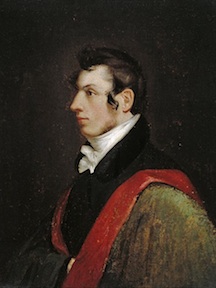By Lauren Martinek
Samuel F. B. Morse (ΦBK, Yale College, 1810) was a painter, advocate for theatre, inventor, and in his later years a philanthropist. He studied religious philosophy, horse sciences, and mathematics while attending Yale College, graduating Phi Beta Kappa in 1810.
Few people would think that the inventor of the telegraph, the man responsible for ushering in the age of near instantaneous communication, was a Renaissance man who started off his career as a painter. Morse, who is now widely remembered for the radio code that bears his name, wanted to go to art school and convinced his father to let him study painting in Europe after Yale.
Morse specialized in landscape paintings but made his career in portrait painting, which was more popular for the era. His commissions kept him in the circle of great thinkers, inventors, and famous war heroes such as the Marquis de Lafayette. The contacts he made as an artist formed a network across the humanities that reflects the spirit of Phi Beta Kappa. As he gained more acclaim, Morse became a staunch advocate for theatre and led a campaign of support amidst debates over whether theatre was intellectual or purely degenerative.
It wasn’t until after tragedy struck that Morse turned to inventing what made him famous. Morse’s wife Lucretia died in 1927 while he was away. A letter had been sent to inform him that she had taken ill, and he returned home as soon as he received the message. However, because of how long it took for the letter to reach him, Morse did not arrive home until after the funeral. He remembered a few lectures he had attended at Yale about electricity and conversations he had had with some inventors about the potential of electric communication. Frustrated with the current communication system, Morse set out to create an electrical signal communication network that would render communication nearly instantaneous. Thus the single wire telegraph was born.
Revolution didn’t happen overnight, though. Morse spent years convincing members of government to invest in establishing the wire infrastructure needed for a telegraph network to operate. He also had to battle a few lawsuits from inventors of similar creations. But Morse was the first to make a telegraph that could send messages over long distances. Soon the telegraph and Morse code gained acclaim and began to be widely used. Telegraph wires were literal lines connecting one place to another, making the fine tendrils of a network of communication that ushered in a new era of communication. The telegraph inspired further inventions such as telephone and radio. The revolution in communication technologies began with the telegraph, however.
In his later years, Morse became a philanthropist. Having been a life-long learner, he thought it important to contribute to the pursuit of higher education. He donated a portion of the fortune that his famed invention earned to Vassar University and to his alma mater. Remembering his early career as a painter, he became the patron of several struggling artists. His entire life Samuel Morse was a man of both the sciences and the humanities, a truly exemplary member of Phi Beta Kappa.
Lauren Martinek is a senior at the State University of New York at Buffalo majoring in environmental studies. The University at Buffalo is home to the Omicron of New York Chapter of Phi Beta Kappa.
Image at top: Samuel F.B. Morse Self-Portrait, 1812.




